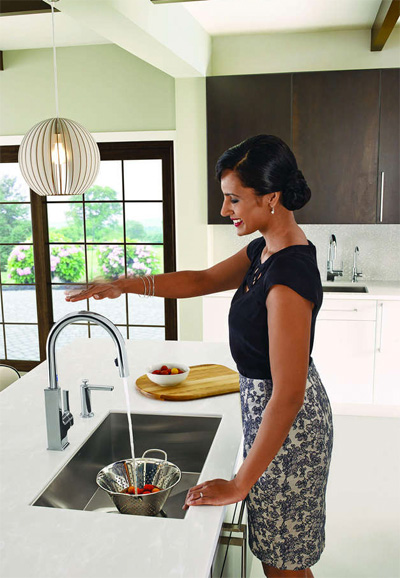Courtney McGeever —
Have you ever wondered how the pieces in your home came to be? Pondered the details of their construction, or what considerations went into ensuring they are not only stylish, but functional and reliable? There is an enormous amount of thought and energy put into crafting products so they flawlessly fit into a home. Thankfully, brands like Moen work tirelessly to thoughtfully design fixtures that integrate seamlessly into your everyday life.
The details behind Moen design
Key insights are at the root of every Moen product. Designers draw inspiration from the latest trends in finishes and materials, as well as study how consumers move in the kitchen and interact with items in the bath and shower. Moen incorporates features homeowners didn’t even know they needed until they discover them in a Moen product. These trend experts proudly craft products people will not only enjoy using, but love seeing incorporated into their home day in and day out.
Moen’s talented group of product designers is led by Steven Ward, director of global design. Ward is the eyes and ears of the design community for the brand. He is well-versed in the latest trends, and translates them into beautifully designed fixtures for both the kitchen and bath.
“People are at the heart of the Moen brand — they’re why we create products, they’re part of everything we do, and their needs and desires come first when designing a product,” said Ward. “It’s our mission to interpret trends in a meaningful way so we’re giving people the look they want, in the form of a product that will be around for the life of their home.”
Trend versus trendy: designing products with longevity

Modern-style faucet and sink.
A style category can develop and change over time. Traditional, transitional and modern are ever-evolving style categories, but are ultimately rooted in consistency. While new products can exhibit a certain style trend, it can still remain a classic or a staple of the style category if people really love it. Some classic furniture pieces, for example, have remained in-tact and current exactly as designed over 40 years ago. Trendy products, and finishes, will come and go, but a style category transforms over a lifetime.
“In a fast-paced digital world, trends seem to constantly evolve, product trends fade in and out,” says Ward. “Our job is to determine which trends have a strong enduring beauty, and design a product that will then remain relevant throughout its lifespan.”
There are three overarching design styles for décor, but now the lines between them are blurred. The hard and fast rules have transformed into more of a “mix and match” approach, allowing consumers to develop a personal style that is fresh and all their own. Some typical design styles include:
- Traditional – Often perceived as formal, traditional design can take on many forms, drawing inspiration from the glamour of the 1920s or 1930s Art Deco movement. It lends itself to vintage pieces or flawless, classic looks.
- Transitional – The blending of contemporary and traditional to create a classic and timeless aesthetic. This style can range from industrial, with oil rubbed bronze or matte black finishes, to an alluring minimalist approach with sleek lines and chrome finishes.
- Modern – This style has come a long way, but the same principles remain static. This look can have a soft, fluid aesthetic, or can be rigid and geometric in nature — incorporating 90˚ angles and square-shaped bases.
One trend that stretches across the design spectrum is the emergence of square-shaped products. Previously, mainstream designs included more geographic cylinders, but now as homeowners become more adventurous, there is a shift towards more angular designs. It’s not only the hard angles seen in contemporary design, but softer, pillowed squares or a mix of geometric forms that fit effortlessly into any home’s décor.
How Canadians interpret their style
Moen loves to take a peek inside consumers’ kitchens and bathrooms to discover the types of styles and designs that make their hearts flutter. In conducting this research, Moen has uncovered some interesting facts specifically about Canadian preferences when it comes to their home décor.
In the kitchen…
Traditional kitchen décor reigns supreme in Canada with 57 percent of Canadians owning this style. However, when selecting their kitchen faucet, an overwhelming 62 percent of those homeowners prefer a faucet with a transitional design.
For the 29 percent of homeowners who prefer transitional décor in the kitchen, it’s not surprising that 57 percent prefer a transitional faucet.
And of the 15 percent who prefer modern kitchen décor, 55 percent prefer a modern-style faucet.
In the bath…
In Canada, modern design rules the bath. According to Moen research, 41 percent prefer modern décor and of those, 46 percent prefer a modern faucet.
Transitional and traditional décor are neck and neck, each receiving 29 percent of consumers preferring those styles. The majority of people prefer transitional faucets in both transitional and traditional décor at 48 percent and 49 percent, respectively.
“A transitional, more modern style is prevalent in Canada due to the influences of European and Asian immigration,” said Ward. “Along with architects and designers who play a key role in influencing design, different cultures bring with them their style preferences, and those tend to learn toward contemporary and transitional.”
The big finish!
Selecting the right finish for a fixture is just as important as the product design. A finish can take a faucet from traditional to transitional, and vice versa, instantly. Typically chrome and softer brushed and stainless finishes are a hallmark of a traditional product, while industrial finishes like bronze and matte black lend themselves to a transitional style. Chrome is also prevalent throughout modern design, selected for its clean, reflective appearance.
“In terms of finish popularity, brushed nickel continues to be a very popular finish for the kitchen,” added Ward. “It’s a universal finish that works well with a number of different design styles from traditional to more contemporary design.”
Of the more trendy finishes, there has been a reemergence of gold being used in home design. It’s a non-metallic shade with a softer finish and can incorporate easily into overall design, blending well with other metals and textures.
Finally, graphite, copper and white are finish trends emerging across all areas of the home. From small appliances to wall colours, these looks can be worked into the home in a big way, or simply used to complement a homeowner’s existing décor.
“The most important thing to keep in mind when designing or updating a home is to be true to your personal aesthetic,” says Ward. “When selecting pieces that will become a part of your everyday, like a faucet, ensure you’re selecting items that offer long-lasting style and beauty to complement a range of design trends and décor choices.”
 TheBulletin.ca Journal of Downtown Toronto
TheBulletin.ca Journal of Downtown Toronto


